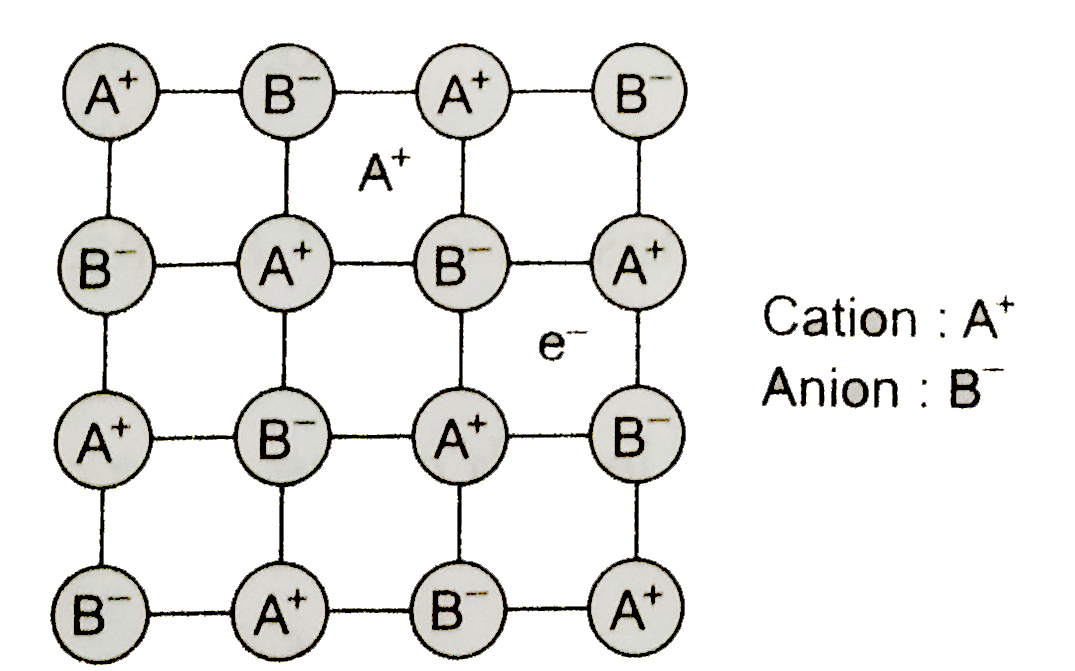The lattice site in a pure crystal cannot be occupied by :
molecule
ion
electron
atom
The correct Answer is:C
To solve the question "The lattice site in a pure crystal cannot be occupied by:", we will analyze the types of particles that can occupy lattice sites in a pure crystal and determine which one cannot.
1. Understanding Lattice Sites:
- In a pure crystal, the lattice sites are the specific positions in the crystal structure where the constituent particles (atoms, ions, or molecules) are arranged in a regular pattern.
2. Identifying Constituents of a Pure Crystal:
- A pure crystal is made up of a single type of constituent, which can be atoms (like in metals), ions (like in ionic compounds), or molecules (like in molecular solids).
- These constituents occupy the lattice points in a fixed stoichiometric ratio.
3. Considering Electrons:
- Electrons are not considered as constituents of a pure crystal. They are subatomic particles that can move freely in certain conditions, especially in conductive materials.
- In a perfect crystal lattice, electrons do not occupy lattice sites; they are typically associated with the bonds between atoms or ions.
4. Conclusion:
- Therefore, in a pure crystal, the lattice sites cannot be occupied by electrons. They can only occupy lattice sites in cases of imperfections or defects in the crystal structure.
5. Final Answer:
- The correct answer is that lattice sites in a pure crystal cannot be occupied by electrons.
- In a pure crystal, the lattice sites are the specific positions in the crystal structure where the constituent particles (atoms, ions, or molecules) are arranged in a regular pattern.
- A pure crystal is made up of a single type of constituent, which can be atoms (like in metals), ions (like in ionic compounds), or molecules (like in molecular solids).
- These constituents occupy the lattice points in a fixed stoichiometric ratio.
- Electrons are not considered as constituents of a pure crystal. They are subatomic particles that can move freely in certain conditions, especially in conductive materials.
- In a perfect crystal lattice, electrons do not occupy lattice sites; they are typically associated with the bonds between atoms or ions.
- Therefore, in a pure crystal, the lattice sites cannot be occupied by electrons. They can only occupy lattice sites in cases of imperfections or defects in the crystal structure.
- The correct answer is that lattice sites in a pure crystal cannot be occupied by electrons.
Topper's Solved these Questions
- THE SOLID STATE BOOK - NCERT FINGERTPS ENGLISHCHAPTER - THE SOLID STATE EXERCISE - ASSERTION & REASON
15 Videos
- THE SOLID STATE BOOK - NCERT FINGERTPS ENGLISHCHAPTER - THE SOLID STATE EXERCISE - Amorphous And Crystalline Solids
3 Videos
- THE SOLID STATE BOOK - NCERT FINGERTPS ENGLISHCHAPTER - THE SOLID STATE EXERCISE - HOTS
7 Videos
- THE P-BLOCK ELEMENTS BOOK - NCERT FINGERTPS ENGLISHCHAPTER - THE P-BLOCK ELEMENTS EXERCISE - Assertion And Reason
15 Videos
Similar Questions
Knowledge Check
When the anionic sites of a crystal are occupied by unpaired electrons, the ionic sites are called............ In diamond inter-particle forces are ......
AF-centres, covalent bondsBF-centres, ionic bondsCCationic, ionic bondsDAnionic, covalent bonds
In a face centred lattice with all the positions occupied by A atoms the body centred octahedral hole in it is occupied by an atom B of an appropriate size for such a crystal, calculate the void space per unit volume of unit cell. Also predict the formula of the compound.
View SolutionIn a covalent solid the lattice points are occupied by
View SolutionThe defect when an ion occupies an interstitial position in the crystal lattice is called
View SolutionA compound of A and B crystallizes in a cubic lattice in which A atoms occupy the lattice points at the corners of a cube and two atoms of B occupy the center of each of the cube faces. What is the formula of this compound?
View SolutionIonic lattic has two major points defects ,(1) Schottky (2) Frenkel defects . Schottkly defects occurs due to the cations - anion pair's missing from the lattice sites . Frenkel defects occurs when cation leaves its lattice site and fits into an interstitial space. The neutrality of the crystal is being maintained and we considered all losses from interstitial positions.
which defect decrease density of the crystal ?
View SolutionIonic lattic has two major points defects ,(1) Schottky (2) Frenkel defects . Schottkly defects occurs due to the cations - anion pair's missing from the lattice sites . Frenkel defects occurs levels its lattic site and fits into an intersitial space. The neturaity of the crystal is benig maintained and we considerd all losses from interstitical positions.
Structure shown here represents :

View SolutionIonic lattic has two major points defects ,(1) Schottky (2) Frenkel defects . Schottkly defects occurs due to the cations - anion pair's missing from the lattice sites . Frenkel defects occurs levels its lattic site and fits into an intersitial space. The neturaity of the crystal is benig maintained and we considerd all losses from interstitical positions.
Structure shown here represents :

View Solution
